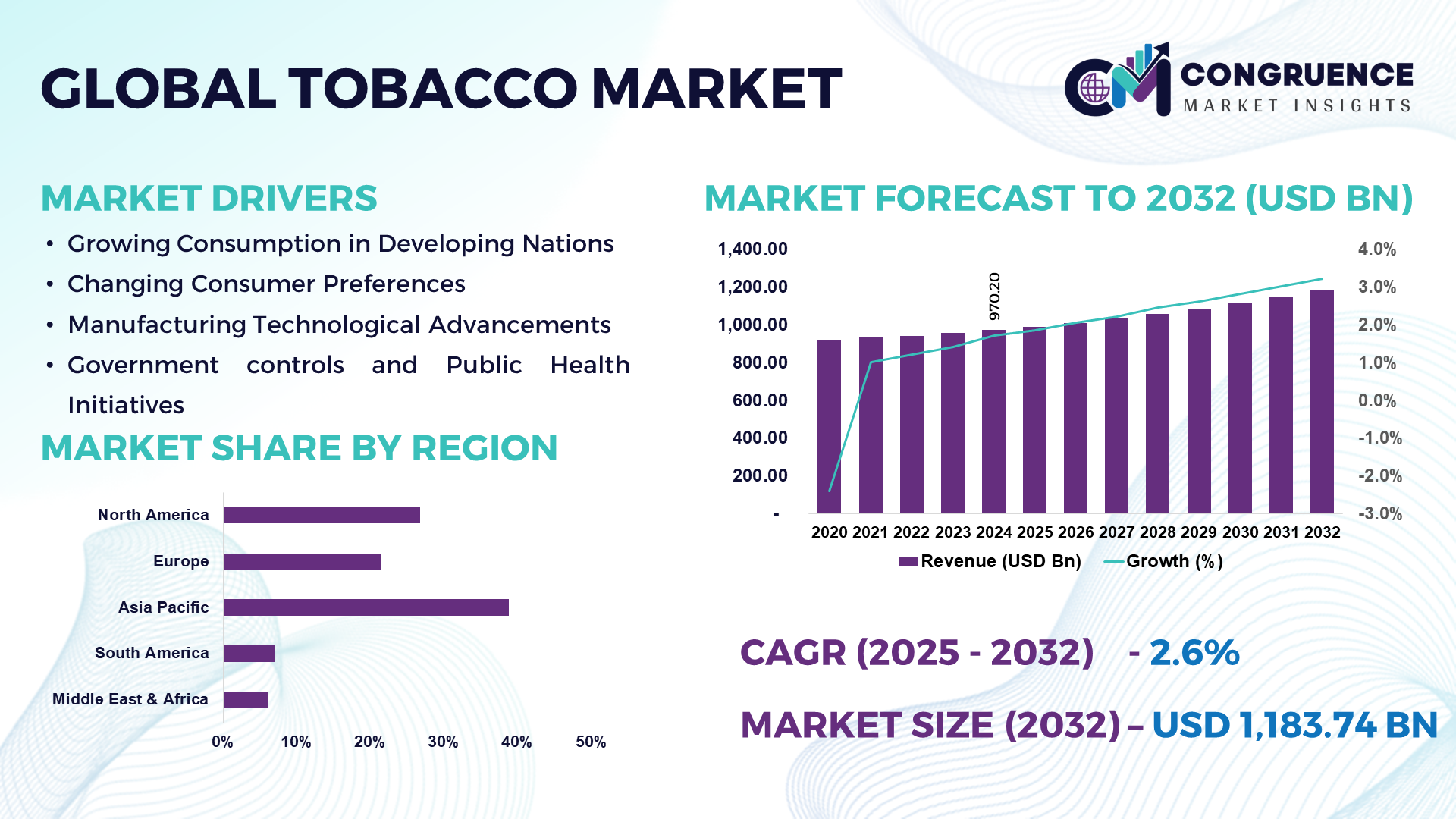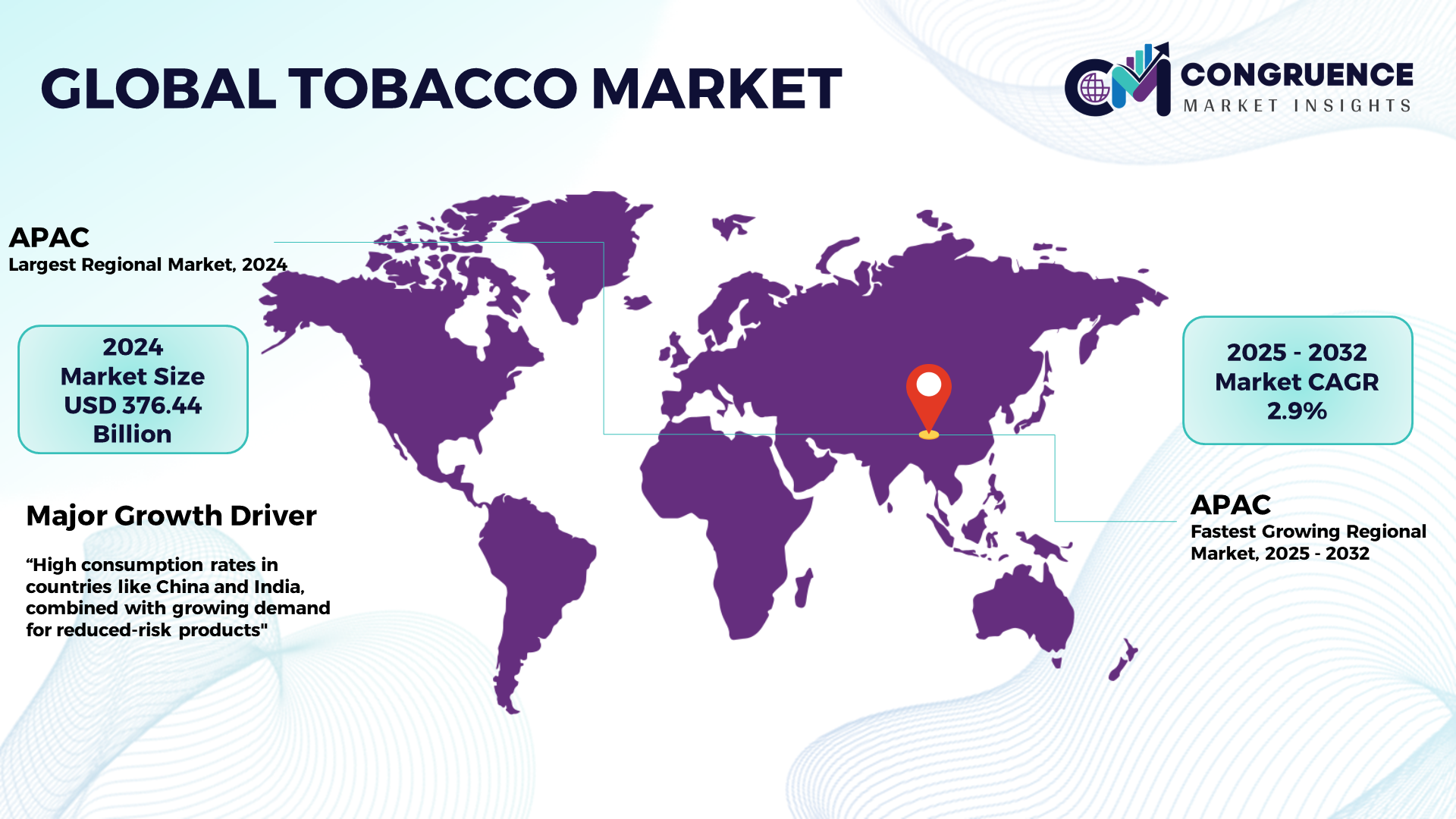Reports
Tobacco Market Size and Forecast 2025 to 2032
The Global Tobacco Market is valued at USD 970.20 Billion in 2024 and is projected to reach USD 1,183.74 Billion by 2032, growing at a CAGR of 2.6% during the forecast period between 2025 and 2032.

To Learn More About This Report, Request A Free Sample Copy
Significant consumption patterns in emerging economies, the growing appeal of next-generation tobacco substitutes, and the ongoing demand for classic tobacco products like cigarettes are the main drivers of this rise. The development of tobacco substitutes and regulatory obstacles will also influence market dynamics in the upcoming years.
With its long history of cultural and economic significance, tobacco is still a significant global industry. The demand for tobacco products is still strong, especially in developing nations, despite increased public health awareness and stricter laws in many nations. The market is changing as a result of the popularity of smokeless tobacco products and next-generation tobacco substitutes like electronic nicotine delivery systems (ENDS) and heated tobacco products (HTPs), which are becoming more and more well-liked by younger customers. As businesses work to adapt to shifting consumer tastes, technological developments and creative goods are reshaping the industry landscape. Stricter laws, anti-smoking efforts, and health concerns are still influencing market patterns, especially in North America and Europe. But because of its high rates of consumption and sizable population, the Asia Pacific area still controls a substantial portion of the industry.
How AI is Transforming Tobacco Market
The global tobacco market is changing, and artificial intelligence is becoming more and more important. It is assisting producers in improving product quality, streamlining their processes, and better adapting to customer trends. AI-driven technologies are being employed in tobacco farming to enhance crop yields through real-time analysis of plant health, weather patterns, and soil quality. This helps tobacco farmers increase production efficiency while lessening their impact on the environment and permits more sustainable agricultural methods. Predictive analytics powered by AI also helps businesses optimize their supply chain, guaranteeing timely delivery of raw materials and completed goods while cutting down on waste and transportation expenses.
AI is also transforming the tobacco industry's product development. Businesses can learn about shifting consumer tastes and adjust their products accordingly, for as by creating innovative nicotine delivery systems and lower-risk items, by analyzing consumer data. More individualized and focused advertising is made possible by AI-powered marketing solutions, which increase consumer engagement and retention. Furthermore, AI helps businesses monitor and comply with changing legal requirements in various jurisdictions, which promotes regulatory compliance. AI will play a more and more crucial role in the tobacco market's efficiency, innovation, and compliance as it develops.
Tobacco Market Major Driving Forces
· Growing Consumption in Developing Nations: Traditional tobacco products like cigarettes and smokeless tobacco are still in high demand due to rapid population expansion and rising disposable incomes, especially in Asia Pacific and Africa.
· Changing Consumer Preferences: One of the main factors propelling market expansion, especially in developed regions, is the rising demand for next-generation tobacco products including e-cigarettes, HTPs, and nicotine pouches.
· Manufacturing Technological Advancements: To improve product consistency, lower operating costs, and streamline production processes, tobacco businesses are implementing modern manufacturing technology.
· Government controls and Public Health Initiatives: Although some areas are experiencing growth limitations due to more stringent controls on traditional tobacco, the creation of less hazardous substitutes offers new opportunities for market expansion.
Tobacco Market Key Opportunities
· Growth of Next-Generation Products: There is a lot of room for expansion given the rising demand for e-cigarettes, HTPs, and other low-risk tobacco products. Customers who are health-conscious and searching for alternatives to conventional smoking ways are served by these products.
· Sustainability Initiatives in Tobacco Farming: As environmental concerns increase, businesses have more opportunities to lessen the environmental impact of tobacco production by implementing sustainable farming practices including AI-driven crop management and precision agriculture.
· Expansion into Emerging Markets: Businesses have the chance to broaden their product lines, especially in the smokeless and traditional tobacco sectors, as a result of the growing tobacco usage in nations like China, India, and portions of Africa.
· Regulatory Flexibility for Novel Products: Nations that offer next-generation tobacco products clear regulatory frameworks give multinational corporations the chance to diversify their product lines in these areas.
Tobacco Market Key Trends
· Growing consumer interest in smokeless tobacco products customers are gravitating toward smokeless alternatives like snus and nicotine pouches as a result of growing awareness of the negative health effects of smoking.
· Changes in Regulations Regarding Tobacco Alternatives: Governments in a number of areas are enacting laws that support the creation and promotion of less hazardous goods, such as e-cigarettes and HTPs.
· Technology Integration in Supply Chain Management: To improve logistics and guarantee supply chain transparency, businesses are increasingly utilizing blockchain and artificial intelligence (AI) technologies.
· Sustainability and Corporate Social Responsibility (CSR): As part of their CSR pledges, tobacco businesses are under increasing pressure to adopt sustainability measures including carbon neutrality and environmentally friendly packaging.
Region-wise Market Insights
Asia Pacifc is the largest market, accounting for 38.8% of the market share in 2024, valued at USD 376.44 Billion. However, Asia Pacific is predicted to expand at a fastest CAGR of 2.9% between 2025 and 2032.

To Learn More About This Report, Request A Free Sample Copy
With a 38.8% market share in 2023, Asia Pacific led the world's tobacco market, which is expected to expand at a compound annual growth rate (CAGR) of 2.9% between 2025 and 2032. Due to their enormous populations and cultural acceptance, nations like China and India are the biggest consumers of traditional tobacco products. Stricter smoking bans and growing health consciousness, on the other hand, are causing a move toward next-generation tobacco substitutes in North America and Europe.
· In April 2024, Philip Morris International (PMI) reported strong growth, driven by rising demand for its smoke-free products like IQOS. The company's transition towards reduced-risk alternatives is gaining momentum as more consumers switch from traditional cigarettes to smoke-free devices, boosting revenue.
The Asia Pacific region's domination is a result of urbanization, the expansion of the middle class, and the expanding accessibility of both traditional and smokeless tobacco products. The move to lower-risk products is being encouraged by European regulatory organizations, which has led to a rise in the use of e-cigarettes and HTPs. Next-generation product usage has also increased in North America, especially in the US. Growing disposable incomes and lax tobacco laws in some regions are predicted to fuel modest development in Latin America and the Middle East and Africa.
Recent Market Developments
· In March 2023, Imperial Brands announced that it is shifting its focus toward newer nicotine and tobacco products, such as e-cigarettes and heated tobacco. The company is adapting to changing consumer preferences by investing in less harmful alternatives while maintaining a smaller portfolio of traditional tobacco products. This strategic transition reflects the industry's broader move towards reduced-risk products, as global regulations around smoking tighten and health concerns grow.
· In October 2022, Altria announced an agreement with Philip Morris International (PMI) to transfer exclusive U.S. rights for IQOS, a heated tobacco device, back to PMI by April 2024. This transition allows PMI to fully market IQOS in the U.S., enhancing their control over its distribution and growth strategy.
Market Competition Landscape
There is fierce rivalry in the global tobacco business, with major competitors fighting for market dominance through brand growth, product innovation, and strategic alliances. Major international corporations including Japan Tobacco International, British American Tobacco, Philip Morris International, and Altria Group control a large portion of the market. These businesses' broad distribution networks, varied product portfolios, and great brand recognition give them a substantial amount of market power. Many businesses are investing in next-generation goods, like e-cigarettes, heat-not-burn (HNB) devices, and smokeless tobacco products, in response to changing consumer preferences and regulatory pressures. Companies are vying for a larger portion of health-conscious consumers as a result of this trend, which has increased competition in the reduced-risk product (RRP) market.
The market is also challenged by rising taxes, government regulations, and anti-smoking initiatives, which force businesses to change their approaches. Companies frequently engage in mergers and acquisitions in an effort to broaden their global reach and diversify their product lines. Businesses that prioritize innovation, environmentally friendly operations, and regulatory compliance will continue to have a competitive advantage in the tobacco sector as the market changes.
Key players in the global tobacco market implement various organic and inorganic strategies to strengthen and improve their market positioning. Prominent players in the market include:
· Philip Morris International
· British American Tobacco
· Japan Tobacco Inc.
· Imperial Brands PLC
· Altria Group, Inc.
· China National Tobacco Corporation
· Swedish Match AB
· Reynolds American Inc.
· ITC Limited
· KT&G Corporation
· Vector Group Ltd.
· Scandinavian Tobacco Group
· Godfrey Phillips India Ltd.
· NTC Industries Ltd.
|
Report Attribute/Metric |
Details |
|
Market Revenue in 2024 |
USD 970.20 Billion |
|
Market Revenue in 2032 |
USD 1,183.74 Billion |
|
CAGR (2025 – 2032) |
2.6% |
|
Base Year |
2024 |
|
Forecast Period |
2025 – 2032 |
|
Historical Data |
2020 to 2024 |
|
Forecast Unit |
Value (US$ Bn) |
|
Key Report Deliverable |
Revenue Forecast, Growth Trends, Market Dynamics, Segmental Overview, Regional and Country-wise Analysis, Competition Landscape |
|
Segments Covered |
· By Product Type (Cigarettes, Cigars, Smoking Tobacco, Smokeless Tobacco, and Next-Generation Products) · By Distribution Channel (Offline, Online) · By End-User (Male, Female) |
|
Geographies Covered |
North America: U.S., Canada and Mexico Europe: Germany, France, U.K., Italy, Spain, and Rest of Europe Asia Pacific: China, India, Japan, South Korea, Southeast Asia, and Rest of Asia Pacific South America: Brazil, Argentina, and Rest of Latin America Middle East & Africa: GCC Countries, South Africa, and Rest of Middle East & Africa |
|
Key Players Analyzed |
Philip Morris International, British American Tobacco, Japan Tobacco Inc., Imperial Brands PLC, Altria Group, Inc., China National Tobacco Corporation, Swedish Match AB, Reynolds American Inc., ITC Limited, KT&G Corporation, Vector Group Ltd., Scandinavian Tobacco Group, Godfrey Phillips India Ltd., NTC Industries Ltd. |
|
Customization & Pricing |
Available on Request (10% Customization is Free) |
